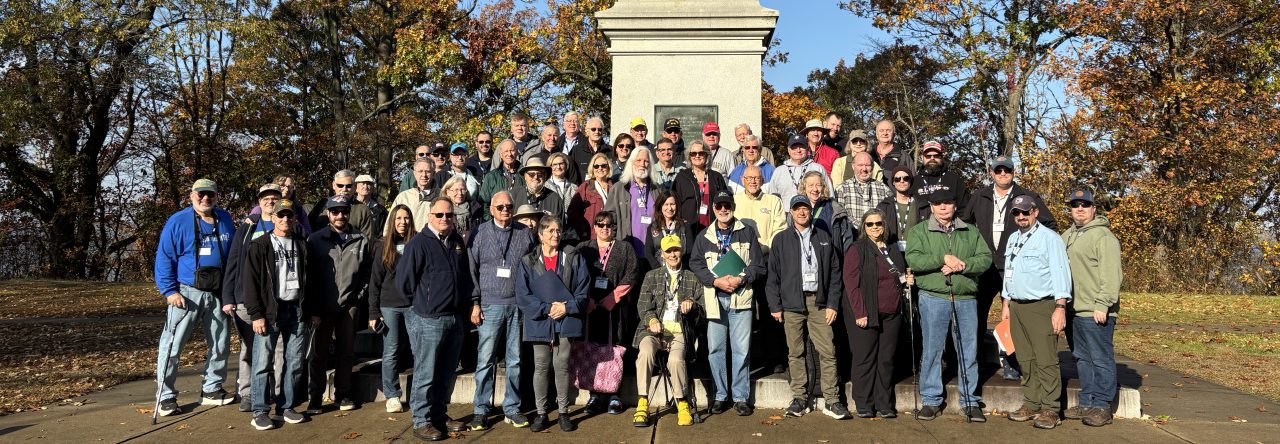In May 1777, large contingents of Native Americans, likely lead by Shawnee Chief Blackfish, crossed the Ohio River into Kentucky and launched a series of attacks on Boonesborough, Harrodsburg, Fort Logan, and their environs. Typically, a raiding party would move into the woods around a town or fort to observe activities while remaining in hiding. Then, they would attack at an opportune moment, ambushing groups outside the fort at their most vulnerable. So it was at Logan’s Fort. Aware that raiders were in the area, the population had moved into the fort. But, the crops, livestock, and cabins outside the fort still needed tending. John Filson, Kentucky’s first historian, highlighted the story in his history of the state, but he relied on Daniel Boone’s account for it. Boone, who was not present, got the day and month of the attack wrong, but his account otherwise held up reasonably well and subsequent historians fleshed out its details.[4]
On May 30, a group of women including Ann Logan, Esther Whitley, and one enslaved black woman, left the fort to milk cows. They were protected by four men: William Hudson, Burr Harrison, John Kennedy, and James Craig.[5] As the milking commenced, concealed Indians began shooting at the party from a cane brake near the town’s original cabins. Hudson was killed while the remainder rushed back to the fort.[6] Kennedy and Harrison were wounded en route. Kennedy made it inside the walls, but Harrison fell some distance away.
After Mrs. Whitley realized Harrison was not dead, Logan attempted to organize a sally to retrieve the man.[7] It was a tall order. Logan’s Fort held but fifteen men, one of whom was dead, one of whom was wounded outside the walls, and one of whom, Kennedy, was wounded inside the walls. The twelve remaining men were responsible for protecting a few dozen women and children, although Mrs. Whitley and Jane Manifee were reportedly excellent shots more than capable of defending their community.[8] The number of enslaved people and their access to firearms is uncertain, but 18th century accounts ignore them as an element in the fort’s defense, suggesting they were not armed. Eventually, John Martin joined Logan and the two men returned to the gate, preparing to rush outside amidst hostile fire and bring Harrison back within the walls.[9] The exact sequence of subsequent events is unclear. In the first version, Harrison began moving, either raising himself up to stagger to the fort or crawling for the gate before or as it opened. Martin changed his mind and opted not to leave the fort, perhaps put off by an increased fire from the surrounding Indians or in the belief that Harrison would be able to reenter the fort without much help.[10] Alternatively, the gate opened first and Harrison moved after Logan and Martin ran just a few paces. At that point, Martin changed his mind and returned to the fort. In both cases, however, Logan opted to press on through the enemy fire. He ran forward, heaved Harrison up into his arms, and returned to the fort amid a hail of enemy fire. Logan made it safely back inside the walls, but Harrison eventually expired.[11]
With the rescue accomplished, both sides settled into regularly firing at one another well into the night. Powder and ammunition were always in short supply and precious on the frontier. Both had to be brought down the Ohio River from Pittsburgh or overland through the Cumberland Gap, and that was only after they had been milled or manufactured farther east. Logan’s Fort began to run out of ammunition first and the women in the fort reportedly began melting pewter plates and utensils and pouring the liquid metal into bullet molds.[12]
Eventually, the shooting petered out, but Native Americans remained in the area on May 31 before withdrawing the next day. Frontier warfare, however, was not as clear cut as European warfare. So-called sieges of fixed locations were more like naval blockades; enemy combatants could remain hidden nearby for lengthy periods waiting to attack any target of opportunity outside a fort’s walls. So, Fort Logan’s inhabitants rightly still perceived danger in the surrounding wilderness. War parties were often moving through the area.
In that context, the acute shortage of powder and ammunition had to be rectified. Harrodsburg and Boonesborough had none to spare and the nearest resupply might be scrounged from settlements in the Holston River region of Virginia, some two hundred miles away. Logan recruited two other men and they slipped out of the fort in the middle of the night. Rather than following well-known trails, they traveled across country by lesser-known paths and through the wilderness. According to tradition, Logan bypassed the Cumberland Gap entirely and went up and over the mountain. He returned in less than ten days, making an average hiking rate of forty miles a day over rough terrain. His men arrived two days later with powder and shot.[13] The feat entered the realm of legend and grew in the retelling. More modern historians estimate a twenty-one day trek, much more reasonable, but still a good pace in the wilderness.[14] Either way, it was a remarkable feat that helps illustrate the desperate straits in which frontier posts often found themselves.
Even with modest resupply, the fort nevertheless remained in a state of heightened alert and danger all summer. That autumn, the county lieutenant, John Bowman, arrived with 100 reinforcements from Virginia. As an advance party approached the fort, concealed Indians fired upon it and killed several men before dispersing. On the bodies of several casualties the Kentuckians found proclamations signed that June by Henry Hamilton. They invited everyone on the frontier to seek refuge in Detroit or another British fort and join the British war effort or be judged rebels and traitors. Logan destroyed the flyers, perhaps to prevent anyone from taking Hamilton up on the offer.[15] Later, Logan’s Fort became a staging area to gather supplies and muster men to support offensives into the Illinois and Ohio Countries in an effort to undermine British power in the west and retaliate against Native American nations allied with them. Today, a reconstructed fort exists in Stanford, Kentucky, testament to the area’s Revolutionary War history.
[1] Lynda Williams Closson, “Battle of Logan’s Fort,” American Battlefield Trust, https://www.battlefields.org/learn/articles/battle-logans-fort. Accessed April 8, 2024.
[2] R.S. Cotterill, History of Pioneer Kentucky (Cincinnati: Johnson and Hardin, 1917), 112.
[3] “Logan’s Fort,” Discover Kentucky Archeology, https://archaeology.ky.gov/Find-a-Site/Pages/Logan’s-Fort.aspx. Accessed April 9, 2024.
[4] John Filson, The Discovery, Settlement, and Present State of Kentucky and an Introduction to the Topography and Natural History of that Rich and Important Country (London: Printed for John Stockdale, 1793), 39-40. Filson’s account is primarily a geography and reads like a sales pitch. He included Boone’s first memoir as an appendix. Filson’s pamphlet was originally published in the United States in 1784 and he disappeared in 1788. The London edition is a reprint that includes original maps by Thomas Hutchison, a former British officer and cartographer with long experience on the frontier who was then the Geographer of Congress.
[5] Mann Butler, A History of the Commonwealth of Kentucky (Cincinnati: Wilcox, Dickerman & Co., 1834), 91; John A. McClung, Sketches of Western Adventure: Containing an Account of the Most Interesting Incidents Connected with the Settlement of the West, from 1755 to 1794 (Philadelphia: Grigg & Elliott, 1832), 127; Closson, “Battle of Logan’s Fort.” The identities of the men guarding the work party are from Closson.
[6] “Logan’s Fort,” Discover Kentucky Archeology.
[7] Butler, 92.
[8] Neal O. Hammon and Richard Taylor, Virginia’s Western War, 1775-1786 (Mechanicsburg, PA: Stackpole Books, 2002), 50-51.
[9] Butler, 92; Cotterill, 116; McClung, 128.
[10] Butler, 92; Cotterill, 116, note 15; McClung, 128.
[11] “Logan’s Fort,” Discover Kentucky Archeology.
[12] McClung, 128.
[13] Butler, 93; McClung, 129; Cotterill, 117. Butler and McClung both emphasize the threat of Indians that threatened to undo Logan’s mission at any moment, but more likely reflects the state of mind of Kentuckians looking into the wilderness from which threats might emerge at any moment. Cotterill downplays the danger, but preposterously suggests Logan made the round trip in two days.
[14] Closson, “Battle of Logan’s Fort.”
[15] Butler, 93; Cotterill, 117-118.

